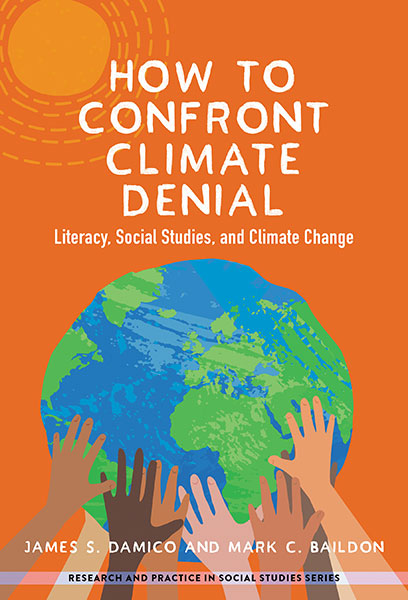 By: James S. Damico and Mark C. Baildon, authors, How to Confront Climate Denial
By: James S. Damico and Mark C. Baildon, authors, How to Confront Climate Denial
James S. Damico is a professor of literacy, culture, and language education at Indiana University, Bloomington and a former elementary and middle school teacher from New Jersey.
Mark C. Baildon is an associate professor in foundations of education at the United Arab Emirates University and a former middle and high school social studies teacher in schools around the world (United States, Israel, Singapore, Saudi Arabia, and Taiwan).
Educators play a vital role in helping students engage with the existential issue of climate change. This post highlights one approach intended for middle level learners and older: how to identify climate change denial in the media.
While a growing number of people in the United States and around the world identify global climate change as an existential threat and are willing to support policies that address this crisis, many still persist in doubting (or not fully accepting) the science or resist the scope and speed of the response needed to mitigate the worst effects of climate change.
We identify these different degrees of doubt or resistance as two distinct forms of climate denial.
- climate science denial, the rejection of the well-established scientific consensus about the causes and consequences of global warming
- climate action denial, the unwillingness or inability to take necessary actions to adequately address the crisis. In this case, the science of climate is accepted; the needed actions are not.
While there is debate about the best solutions to address global warming across particular contexts, what remains undeniable is the need for a rapid transition to a net zero carbon global economy (net zero is the state when greenhouse gases entering the atmosphere are balanced by their removal from the atmosphere).
Discerning climate change denial in the media: An example from YouTube
Techniques or tactics for promulgating climate denial are well-documented—for example, see John Cook’s work with the FLICC Model; William F. Lamb and colleagues, who delineate discourses of climate delay; and the work of Geoffrey Supran and Naomi Oreskes, who describe frames used in climate change communication. The work of these scholars can help guide educators to detect climate denial in any number of texts or information sources.
Let’s consider an example, a one-minute YouTube video called “Nature-based solutions and Shell/New Energies” that is part of Royal Dutch Shell Oil’s #MakeTheFuture campaign:
Today, large fossil fuel companies like Shell dedicate less time and resources advancing climate science denial in their public-facing communications, yet there is no shortage of ways that these companies advance climate action denial. This YouTube is a prime example of this form of denial with greenwashing the most striking tactic or frame being employed. Greenwashing is a corporation’s attempt to portray an ecologically responsible image.
In this YouTube clip, the voiceover text states: “Trees are vital in the fight against climate change” and that “Shell is harnessing nature, supporting reforestation projects, and protecting forests under threat.” These claims are made amidst visual images of forests and landscapes that communicate the ‘greenness’ of Shell’s ‘clean energy’ efforts. All this deflects attention from the impact of the company’s new oil production facilities and its continued emissions.
Another denial frame or tactic is “individualized responsibility,” which emphasizes individual accountability rather than government or corporate responsibility for climate action. This YouTube video employs this frame when the narrator states that all of Shell’s attempts to “harness nature” and “protect forests” is ultimately in the service of “making it easier for customers to tackle their own emissions.”
This video also uses a misinformation technique called “paltering,” when companies make claims that are true yet misleading (Cook, 2020). Fossil fuel companies might truthfully assert that they are advancing lower carbon climate solutions, including commitments to renewable energy, yet they continue to increase fossil fuel production (Taft & Atkin, 2021). For example, while it is true that in 2020 Shell set aside $2 to $3 billion annually to promote low-carbon initiatives, this figure paled in comparison to its $17 billion commitment to its fossil fuels operations (Carrington, 2021). For all these reasons, this YouTube video represents climate action denial.
Making teaching about climate change denial a priority
Educators across academic subject areas and working with learners across age levels—from primary school through postsecondary settings—can all play a vital role in helping students engage with the existential issue of climate change. The approach we take in our recent book, How to Confront Climate Denial: Literacy, Social Studies, and Climate Change (Damico & Baildon, 2022), is to explore why and how educators can help learners confront climate denial and advance ecological justice. Focusing on climate change denial in the media is one essential component of this work.
References
Carrington, D. (2021, April 19). “A great deception”: Oil giants taken to task over “greenwash” ads. The Guardian.
Cook, J. (2020). Deconstructing climate science denial. In Holmes, D. & Richardson, L. M. (Eds.) Edward Elgar Research Handbook in Communicating Climate Change (pp. 62-78). Edward Elgar.
Damico, J.S. & Baildon, M. (2022). How to Confront Climate Denial: Literacy, Social Studies, and Climate Change. Teachers College Press.
Lamb, W. F., Mattioli, G., Levi, S., Roberts, J. T., Capstick, S., Creutzig, F., … & Steinberger, J. K. (2020). Discourses of climate delay. Global Sustainability, 3.
Supran, G., & Oreskes, N. (2021). Rhetoric and frame analysis of ExxonMobil’s climate change communications. One Earth, 4(5), 696-719.
Taft, M., & Atkin, E. (2021, October 27). Big oil uses newsletter ads to spread misinformation ahead of big oil misinformation hearing. Gizmodo.
Featured image by Karolina Grabowska via Pexels
